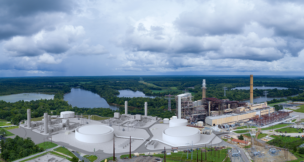
The Virginia Inland Port in Front Royal. Photo courtesy Port of Virginia

The Virginia Inland Port in Front Royal. Photo courtesy Port of Virginia
Virginia inland ports expand to meet shipping demand
Mason Adams //April 30, 2025//
SUMMARY:
- $15M invested in upgrades at Virginia Inland Port
- RMT improvements cut gate times, add lighting for barge ops
- Norfolk harbor widened to allow two-way container ship traffic
- Study underway on potential inland port in Southwest Virginia
The Virginia Inland Port in Front Royal and Richmond Marine Terminal are making investments to keep ahead of freight-shipping demand, while still determining whether there’s enough demand to justify a new inland port in Southwest Virginia.
The Port of Virginia‘s improvements to its two inland properties come at a time when it’s also finishing deepening the harbor at its Norfolk terminal to accommodate larger ships and bigger volumes. In 2024, the port completed widening the harbor, allowing ultra-large container ships to pass two at a time.
The recently completed $15 million capital improvements at the 161-acre Virginia Inland Port complement the dredging project, expanding railroad track that can handle larger trains. Additionally, the inland port added container handling equipment repurposed from a Hampton Roads terminal. The port spent $6.1 million to make upgrades at RMT, improving gate passage times and providing more light to extend barge loading and unloading into the evening.
“The time was right to get the Virginia Inland Port ready for the future,” says Port of Virginia spokesman Joe Harris. “The terminal is growing, volumes are growing, and we wanted to be ready so we don’t want to have to play catch up.”
The improvements have boosted efficiency at the port so trucks can move in and out more quickly, says Dale Bennett, president and CEO of the Virginia Trucking Association. “The biggest complaint you get about any port is drivers facing delays in delivering and picking up cargo,” Bennett says. The port’s capital improvements directly address that concern.
As for replacing older equipment with carbon-free, electric alternatives at the port’s facilities, that’s still rolling along, even with President Donald Trump’s rollback of former President Joe Biden’s clean energy legislation, including federal funding to cut 3 million metric tons of carbon emissions through electrification and other methods.
“Right now as we speak, all of our terminals — Richmond, Virginia International Gateway, Norfolk, VIP, Newport News — are all powered by clean energy,” Harris says. “We are getting electricity off the grid for our terminals to use, and then backfilling exactly what we use with clean power taken from solar or wind or nuclear. We understand the administration has a different look at sustainability, but we’re going forward with our 2040 net-zero goal — not under a mandate, but our own goal.”
As for a Southwest Virginia inland port — much desired by politicians in that corner of the state, as well as economic development officials — there wasn’t much movement in 2025.
The Virginia Port Authority is currently conducting a study to determine the viability of adding an inland port at an industrial park in Washington County, and county officials are improving nearby industrial sites that may see more interest if the state’s second inland port is built nearby.
According to the port’s latest update to the General Assembly, filed on March 1, “The business case for the facility is complex.” Part of the complexity is lining up an inland port with local rail lines and other infrastructure, as well as the persistent question of whether there’s enough cargo volume to justify an inland port.
“It’s not one of those things we should venture out and build without substantial commitments from users,” says Devon Anders, president of Rockingham County-based third-party logistics company InterChange, situated near the Virginia Inland Port.
If it’s successful, the port could attract business from ports in Charleston, South Carolina, and Savannah, Georgia, and beyond. But the port authority should get commitments from shippers before it moves forward with construction, Anders advises.
n















